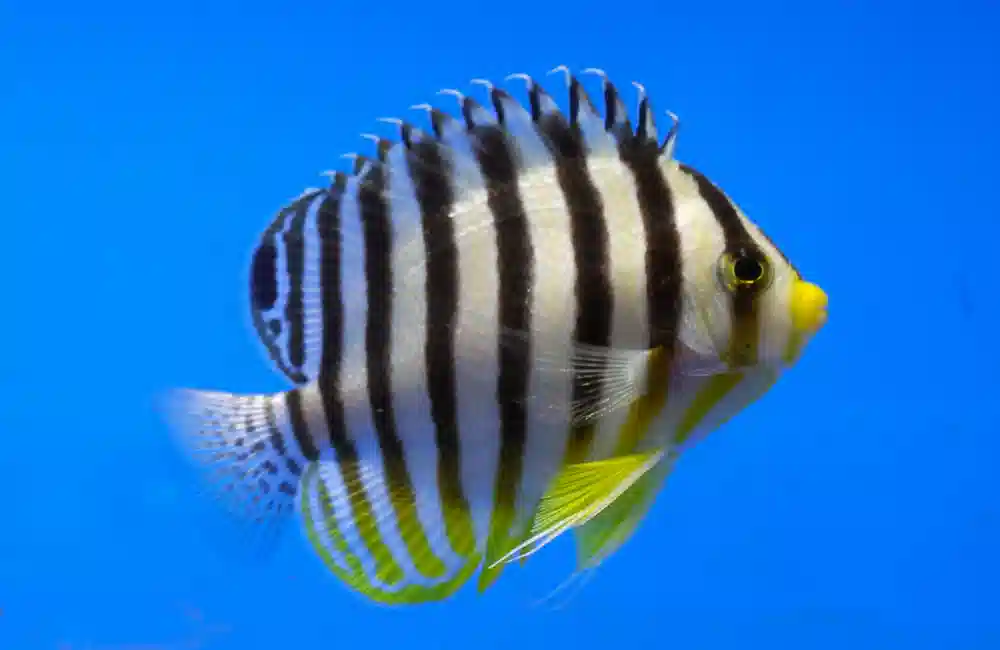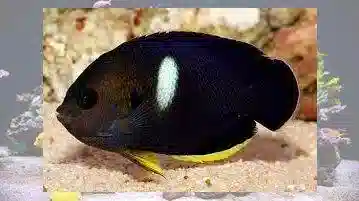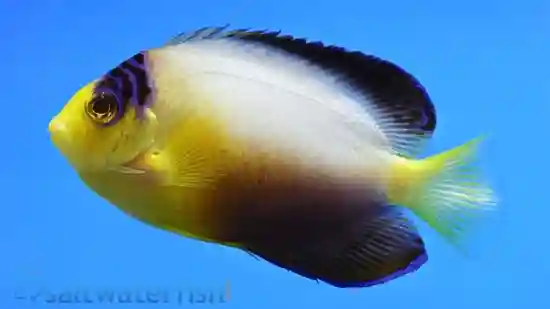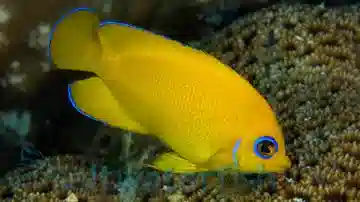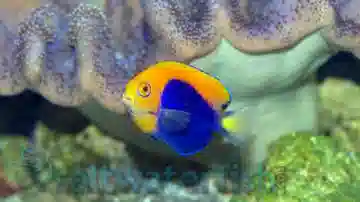Flameback Angelfish - Africa
Centropyge acanthops
(2 Reviews)

Flameback Angelfish - Africa
Centropyge acanthops
(2 Reviews)
{{ item.name }}
Size: {{ item.extra_field_3 }}
${{ getFormattedPrice(item.saleprice) }} ${{ getFormattedPrice(item.price) }}
To join the waiting list, click here
Free Shipping
With
$199.00
or more in Marine Life.
More details...
Flameback Angelfish - Africa Care Facts
| Care Level: | Moderate |
|---|---|
| Temperament: | Semi-Aggressive |
| Diet: | Omnivore |
| Reef Safe: | Yes -With Caution |
| Minimum Tank Size: | 30 gallons |
| Max Size: | 3-4 inches |
The Flameback Angelfish,Centropyge acanthops, also known as the African Pygmy Angelfish, and Orangeback Angel, features an orange and yellow dorsal fin, an orange eye, and a deep blue body with a clear tail. As one of the smallest members of the Centropyge family, the Flameback Angel is not necessarily reef safe as it picks on coral mucous and small sessile inverts. The Flameback Angel is a hardy fish, and has an omnivorous diet of natural algae and brine and mysis shrimp. They are an egg-scattering species and can be bred in captivity. They require a tank of at least 30 gallons, plenty of live rock and open swimming space. It is semi-aggressive and will defend their territory, but usually will not bother other tank mates. They may nip at some soft and polyp corals. Overall, the Flameback Angel is a beautiful, relatively peaceful fish that will go great in most home aquariums.
African Flameback Angelfish (Centropyge acanthops): Your Complete Guide
The African Flameback Angelfish, scientifically known as Centropyge acanthops, is a striking addition to marine aquariums that captivates hobbyists with its vibrant colors and unique personality. This comprehensive guide provides essential information about this species, including its habitat, reef compatibility, size, lifespan, dietary needs in captivity, availability through aquaculture, compatibility with other marine inhabitants, sexual dimorphism, juvenile to adult coloration changes, temperament, tank requirements, and precise water conditions. We'll also explore common names for this species and compelling reasons to purchase the African Flameback Angelfish from Saltwaterfish.com.
Habitat and Natural Range
The African Flameback Angelfish is typically found in the Western Indian Ocean, primarily in regions around the African coastlines. In the wild, they inhabit coral reefs and rocky outcrops with abundant coral growth. Understanding their natural environment is essential for recreating suitable conditions within your aquarium.
Reef Compatibility
Regarding reef compatibility, the African Flameback Angelfish is generally considered reef-safe. They are not known to harm corals or invertebrates in your reef aquarium. However, individual fish may display unique behaviors, so monitoring their interactions is essential.
Size and Lifespan
African Flameback Angelfish are relatively small, typically reaching 3 to 4 inches (7.6 to 10.2 centimeters) when fully grown. They can live for 5 to 7 years with proper care, making them a delightful and long-lasting addition to your marine setup.
Diet in Captivity
Feeding African Flameback Angelfish in captivity is relatively straightforward. Provide them with a balanced diet that includes:
- High-Quality Marine Pellets: Offer high-quality marine pellets designed explicitly for angelfish to meet their nutritional needs.
- Frozen Foods: Supplement their diet with frozen foods such as mysis shrimp, brine shrimp, and other marine preparations to ensure a diverse and nutritious diet.
- Algae and Plant Matter: Incorporate marine algae and vegetable matter, such as seaweed sheets, to mimic their natural grazing habits.
Aquaculture and Availability
African Flameback Angelfish are occasionally available through aquaculture efforts, but their availability may vary. It's advisable to check with reputable suppliers like Saltwaterfish.com for current availability.
Compatibility with Other Fish and Invertebrates
African Flameback Angelfish are generally peaceful, but their temperament may change as they mature. Here are five compatible tankmates for your African Flameback Angelfish:
- Clownfish: Clownfish species like the Ocellaris Clownfish (Amphiprion ocellaris) and Percula Clownfish (Amphiprion percula) can coexist peacefully.
- Firefish: Firefish species, such as the Firefish Goby (Nemateleotris magnifica), make suitable tankmates given adequate hiding spots.
- Gobies: Certain goby species, including the Yasha White Ray Shrimp Goby (Stonogobiops yasha), are compatible due to their small size and peaceful demeanor.
- Blennies: Blennies, such as the Tailspot Blenny (Ecsenius stigmatura), are generally compatible with ample hiding spots.
- Tangs and Surgeonfish: Tangs like the Yellow Tang (Zebrasoma flavescens) and other surgeonfish species can coexist, especially in larger aquariums.
Sexual Dimorphism
African Flameback Angelfish do not exhibit significant sexual dimorphism, making it challenging to visually distinguish between males and females.
Juvenile to Adult Coloration Changes
Juvenile African Flameback Angelfish exhibit striking coloration, with a deep blue body adorned with bright orange accents and vertical bars. As they mature into adults, their colors become even more vibrant, making them a stunning focal point in your aquarium.
Temperament
African Flameback Angelfish are generally known for their peaceful temperament, making them suitable for community marine setups. However, they may become territorial as they mature. Providing ample hiding spots and closely monitoring their behavior can help mitigate potential aggression.
Tank Requirements
To ensure the well-being of your African Flameback Angelfish, consider the following tank requirements:
- Minimum Aquarium Size: A tank with a capacity of at least 30 gallons (113 liters) is suitable for a single African Flameback Angelfish. Larger tanks are necessary for multiple angelfish or additional tankmates.
- Live Rock and Hiding Spots: Incorporate live rock formations and hiding spots to replicate their natural habitat and offer shelter.
- Water Conditions: Maintain stable water parameters, including a pH level between 8.1 and 8.4, salinity ranging from 1.020 to 1.025, a water temperature of 75 to 82°F (24 to 28°C), and adequate water flow to mimic their natural environment.
- Lighting: Provide moderate to high-intensity lighting, as it complements the vibrant coloration of African Flameback Angelfish and supports beneficial algae growth.
Other Common Names
The African Flameback Angelfish may also be known as the Flameback Angelfish or Orangeback Angelfish due to its distinctive coloration.
Why Choose the African Flameback Angelfish from Saltwaterfish.com
Purchasing your African Flameback Angelfish from Saltwaterfish.com offers several advantages:
Quality Assurance: Saltwaterfish.com is dedicated to providing healthy and well-acclimated marine fish, ensuring the best start for your new addition.
Expertise and Support: With years of industry experience, Saltwaterfish.com offers valuable insights and assistance to help you succeed in caring for your African Flameback Angelfish.
Convenience: Saltwaterfish.com offers a user-friendly online platform for a convenient and hassle-free purchasing experience.
Ethical Sourcing: By choosing Saltwaterfish.com, you support responsible sourcing practices and marine conservation, contributing to the sustainability of marine ecosystems.
In conclusion, the African Flameback Angelfish (Centropyge acanthops) is a captivating addition to your saltwater aquarium, provided you adhere to suitable tank conditions and proper care guidelines. Consider this species for its striking appearance and charming behavior, and explore the possibilities it offers in your marine setup.
I have had mine for 24 hrs. Beautiful, healthy fish. Much more beautiful than in pictures.
Reviewed by: Robert Lavin on Jan. 6, 2024
The Flameback Angelfish - Africa was received in great shape and has added life to my saltwater aquarium. Thanks
Reviewed by: Noel Henricks on Sept. 11, 2021


